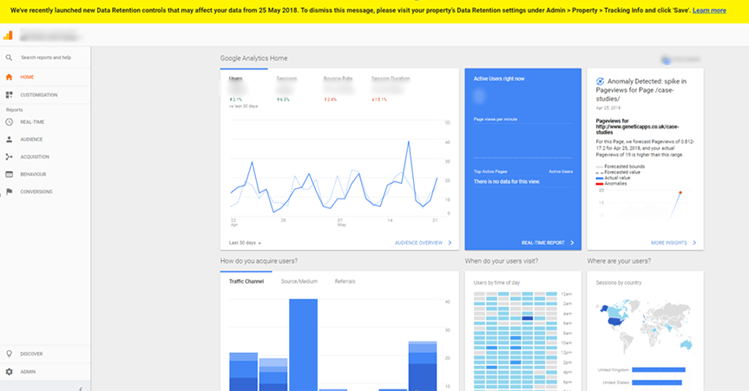What comes to mind when you think about the operation of a successful ecommerce store? Maybe you think about the rich creativity required to corner a market with an exceptional product, or the comprehension of consumer wants and needs that allows elite copywriters to make even the most average item sound incredibly desirable.

Perhaps you envision superlative store designs that make it maximally easy for shoppers to find and order exactly what they’re looking for, or even the kind of industry-leading support that turns would-be one-time buyers into loyal long-serving customers. Well, each and every one of these things can play a part in leading an ecommerce retailer to success — but what underpins them?
You surely guessed due to the title of this post, but the answer is data analysis. It needs to play a key role in every facet of running an online store, and while sellers do try to get ahead without it, they invariably find that it’s a self-destructive path to take. Allow me to explain why.
The Ecommerce Industry is Incredibly Competitive
All of the elements of a hit online retail store that I covered in the intro are not necessarily sufficient to guarantee great performance, because sellers don’t operate in commercial vacuums. How well they’re received is determined by what they bring to the table relative to their competitors — and the ecommerce industry is extremely competitive.
It actually gets tougher with each passing year for various reasons: traditional retailers accept the need to move online, budding entrepreneurs decide to go into business for themselves, and standards improve across the board. You’re likely aware of the low barrier to entry making ecommerce seem so appealing, with cheap store-building tools and endless advice on tap. Well, things are only that simple until you hit the enterprise level.
There’s a reason why top-tier platforms cost so much (business tiers of Magento’s start at $2000 per month, and things escalate from there), and it’s that every last scrap of performance is needed. How much inconvenience would you have put up with to place an online order five years ago, and how much would you accept today? Vastly less, no doubt. Shoppers have become accustomed to incredible convenience.
Relying on Gut Feeling is a Bad Move
The point I’m making here is that the margins are frustratingly narrow at the best of times, and this goes for every ecommerce business model: print-on-demand stores have niche appeal, full service manufacturers-and-sellers can lose heavily if R&D investment doesn’t pay off, and dropshippers have myriad hurdles to overcome (making the best of PPC, finding the right products, setting ideal margins, nailing CTAs, etc.) to even be viable.
Due to this, simply going with your gut feeling about the relative quality of your store won’t suffice. Only granular data analysis will allow you to delve deep enough into your configuration to find the miniscule opportunities for improvement that can ultimately make all the difference for your fortune, whatever your business configuration may be.
On top of your internal analysis, you can look elsewhere in your industry to yield useful data regarding things like competitor pricing, then use that data to inform your own settings. This also enables useful automation such as pricing optimisation: simply define your parameters and leave the process to raise and lower your prices as required.
Feedback Alone Won’t Give You the Whole Story
One way that merchants avoid dealing with analytics is by concentrating on company feedback from customers and prospects alike. They send out detailed surveys with modest incentives to encourage responses, and put time into monitoring social media for brand mentions so they can reach out to people directly for comment.
To be clear, this isn’t a bad idea. It’s actually an excellent idea to gather store feedback: the more you know about what people think of you, the more you can do to make your store better and more appealing to your target audience. The problem — much like the problem with relying on having a good store — is that it isn’t enough to get you ahead.
Consider that people don’t always know exactly what they want, or why they make the decisions they do. We’re not resolutely logical creatures: we get angry, excited, mad, or sad, and we do things that we otherwise wouldn’t without being fully aware of it. So when someone responds in depth to your survey, you need context for their comments.
You might find, for instance, that all your customers say they really enjoy your blog but your digital analytics suggest that your blog posts get very few views (and those who do visit don’t stick around for very long). Those customers might assume your blog is fine, have no particular objection to it, and thus decide to be positive about it — even though it isn’t helpful.
By bringing together the raw data from the performance of your store and the fleshed-out feedback from your visitors and customers, you can form a much clearer picture of what’s going on, and use the resulting insight to achieve major improvements.
Mistakes Compound if They’re Not Addressed
Lastly, data analysis is so important because the minor issues it identifies aren’t solely valuable because they can give your store an edge: they’re also valuable because they will typically compound over time, turning into major issues that can be hugely damaging if not treated early.
Think about the chain of a marketing funnel, with each step pushing the prospective customer to the next in the hope of eventually getting them to the point of conversion. If just one step in that chain has a minor issue (maybe a landing page has weak copy, loads slowly, or features a broken link), it can sabotage the entire chain.
You can — and should — manually review your store on a semi-regular basis, and take note of customer comments about issues with notable pages. But the bigger your store gets, and the more pages it features, the harder that will be to do comprehensively. Data analysis can cover exponentially more ground, highlighting small problems so you can deal with them.






![The Power Of Push Notifications For Small Businesses [Infographic]](https://vermont-towns.org/wp-content/uploads/2021/04/the-power-of-push-notifications-for-small-businesses-infographic-768x512.jpg)